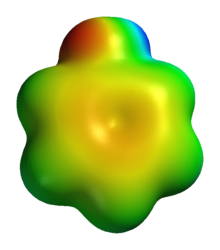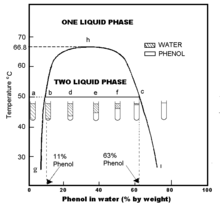
A | B | C | D | E | F | G | H | CH | I | J | K | L | M | N | O | P | Q | R | S | T | U | V | W | X | Y | Z | 0 | 1 | 2 | 3 | 4 | 5 | 6 | 7 | 8 | 9
| |||
| |||

| |||
| Names | |||
|---|---|---|---|
| Preferred IUPAC name
Phenol[1] | |||
| Systematic IUPAC name
Benzenol | |||
Other names
| |||
| Identifiers | |||
3D model (JSmol)
|
|||
| ChEBI | |||
| ChEMBL | |||
| ChemSpider | |||
| DrugBank | |||
| ECHA InfoCard | 100.003.303 | ||
| KEGG | |||
PubChem CID
|
|||
| RTECS number |
| ||
| UNII | |||
| UN number | 2821 (solution) 2312 (molten) 1671 (solid) | ||
CompTox Dashboard (EPA)
|
|||
| |||
| |||
| Properties | |||
| C6H6O | |||
| Molar mass | 94.113 g/mol | ||
| Appearance | Transparent crystalline solid | ||
| Odor | Sweet and tarry | ||
| Density | 1.07 g/cm3 | ||
| Melting point | 40.5 °C (104.9 °F; 313.6 K) | ||
| Boiling point | 181.7 °C (359.1 °F; 454.8 K) | ||
| 8.3 g/100 mL (20 °C) | |||
| log P | 1.48[2] | ||
| Vapor pressure | 0.4 mmHg (20 °C)[3] | ||
| Acidity (pKa) |
| ||
| Conjugate base | Phenoxide | ||
| UV-vis (λmax) | 270.75 nm[5] | ||
| 1.224 D | |||
| Pharmacology | |||
| C05BB05 (WHO) D08AE03 (WHO), N01BX03 (WHO), R02AA19 (WHO) | |||
| Hazards | |||
| GHS labelling: | |||
   [6] [6]
| |||
| Danger | |||
| H301, H311, H314, H331, H341, H373[6] | |||
| P261, P280, P301+P310, P305+P351+P338, P310[6] | |||
| NFPA 704 (fire diamond) | |||
| Flash point | 79 °C (174 °F; 352 K) | ||
| Explosive limits | 1.8–8.6%[3] | ||
| Lethal dose or concentration (LD, LC): | |||
LD50 (median dose)
|
| ||
LDLo (lowest published)
|
| ||
LC50 (median concentration)
|
| ||
| NIOSH (US health exposure limits): | |||
PEL (Permissible)
|
TWA 5 ppm (19 mg/m3) [3] | ||
REL (Recommended)
|
| ||
IDLH (Immediate danger)
|
250 ppm[3] | ||
| Safety data sheet (SDS) | |||
| Related compounds | |||
Related compounds
|
|||
Except where otherwise noted, data are given for materials in their standard state (at 25 °C , 100 kPa).
| |||
Phenol (also known as carbolic acid, phenolic acid, or benzenol) is an aromatic organic compound with the molecular formula C6H5OH.[5] It is a white crystalline solid that is volatile. The molecule consists of a phenyl group (−C6H5) bonded to a hydroxy group (−OH). Mildly acidic, it requires careful handling because it can cause chemical burns.[5]
Phenol was first extracted from coal tar, but today is produced on a large scale (about 7 million tonnes a year) from petroleum-derived feedstocks. It is an important industrial commodity as a precursor to many materials and useful compounds.[8] It is primarily used to synthesize plastics and related materials. Phenol and its chemical derivatives are essential for production of polycarbonates, epoxies, explosives, Bakelite, nylon, detergents, herbicides such as phenoxy herbicides, and numerous pharmaceutical drugs.[9]
Properties
Phenol is an organic compound appreciably soluble in water, with about 84.2 g dissolving in 1000 ml (0.895 M). Homogeneous mixtures of phenol and water at phenol to water mass ratios of ~2.6 and higher are possible. The sodium salt of phenol, sodium phenoxide, is far more water-soluble. It is a combustible solid (NFPA rating = 2). When heated, phenol produces flammable vapors that are explosive at concentrations of 3 to 10% in air. Carbon dioxide or dry chemical extinguishers should be used to fight phenol fires.[5]
Acidity
Phenol is a weak acid (pH 6.6). In aqueous solution in the pH range ca. 8 - 12 it is in equilibrium with the phenolate anion C6H5O− (also called phenoxide or carbolate):[10]

Phenol is more acidic than aliphatic alcohols. Its enhanced acidity is attributed to resonance stabilization of phenolate anion. In this way, the negative charge on oxygen is delocalized on to the ortho and para carbon atoms through the pi system.[11] An alternative explanation involves the sigma framework, postulating that the dominant effect is the induction from the more electronegative sp2 hybridised carbons; the comparatively more powerful inductive withdrawal of electron density that is provided by the sp2 system compared to an sp3 system allows for great stabilization of the oxyanion. In support of the second explanation, the pKa of the enol of acetone in water is 10.9, making it only slightly less acidic than phenol (pKa 10.0).[5] Thus, the greater number of resonance structures available to phenoxide compared to acetone enolate seems to contribute little to its stabilization. However, the situation changes when solvation effects are excluded.
Hydrogen bonding
In carbon tetrachloride and in alkane solvents, phenol hydrogen bonds with a wide range of Lewis bases such as pyridine, diethyl ether, and diethyl sulfide. The enthalpies of adduct formation and the −OH IR frequency shifts accompanying adduct formation have been compiled.[12] Phenol is classified as a hard acid.[13][14]
Tautomerism

Phenol exhibits keto-enol tautomerism with its unstable keto tautomer cyclohexadienone, but the effect is nearly negligible. The equilibrium constant for enolisation is approximately 10−13, which means only one in every ten trillion molecules is in the keto form at any moment.[15] The small amount of stabilisation gained by exchanging a C=C bond for a C=O bond is more than offset by the large destabilisation resulting from the loss of aromaticity. Phenol therefore exists essentially entirely in the enol form.[16] 4, 4' Substituted cyclohexadienone can undergo a dienone–phenol rearrangement in acid conditions and form stable 3,4‐disubstituted phenol.[17]
For substituted phenols, several factors can favor the keto tautomer: (a) additional hydroxy groups (see resorcinol) (b) annulation as in the formation of naphthols, and (c) deprotonation to give the phenolate.[18]
Phenoxides are enolates stabilised by aromaticity. Under normal circumstances, phenoxide is more reactive at the oxygen position, but the oxygen position is a "hard" nucleophile whereas the alpha-carbon positions tend to be "soft".[19]
Reactions


Phenol is highly reactive toward electrophilic aromatic substitution. The enhanced nucleophilicity is attributed to donation pi electron density from O into the ring. Many groups can be attached to the ring, via halogenation, acylation, sulfonation, and related processes.
Phenol is so strongly activated that bromination and chlorination lead readily to polysubstitution.[20] The reaction affords 2- and 4-substituted derivatives. The regiochemistry of halogenation changes in strongly acidic solutions where PhOH2+ predominates. Phenol reacts with dilute nitric acid at room temperature to give a mixture of 2-nitrophenol and 4-nitrophenol while with concentrated nitric acid, additional nitro groups are introduced, e.g. to give 2,4,6-trinitrophenol. Friedel Crafts alkylations of phenol and its derivatives often proceed without catalysts. Alkylating agents include alkyl halides, alkenes, and ketones. Thus, adamantyl-1-bromide, dicyclopentadiene), and cyclohexanones give respectively 4-adamantylphenol, a bis(2-hydroxyphenyl) derivative, and a 4-cyclohexylphenols. Alcohols and hydroperoxides alkylate phenols in the presence of solid acid catalysts (e.g. certain zeolite). Cresols and cumyl phenols can be produced in that way.[21]
Aqueous solutions of phenol are weakly acidic and turn blue litmus slightly to red. Phenol is neutralized by sodium hydroxide forming sodium phenate or phenolate, but being weaker than carbonic acid, it cannot be neutralized by sodium bicarbonate or sodium carbonate to liberate carbon dioxide.
- C6H5OH + NaOH → C6H5ONa + H2O
When a mixture of phenol and benzoyl chloride are shaken in presence of dilute sodium hydroxide solution, phenyl benzoate is formed. This is an example of the Schotten–Baumann reaction:
- C6H5COCl + HOC6H5 → C6H5CO2C6H5 + HCl
Phenol is reduced to benzene when it is distilled with zinc dust or when its vapour is passed over granules of zinc at 400 °C:[22]
- C6H5OH + Zn → C6H6 + ZnO
When phenol is treated with diazomethane in the presence of boron trifluoride (BF3), anisole is obtained as the main product and nitrogen gas as a byproduct.
- C6H5OH + CH2N2 → C6H5OCH3 + N2
Phenol and its derivatives react with iron(III) chloride to give intensely colored solutions containing phenoxide complexes.
Production
Because of phenol's commercial importance, many methods have been developed for its production, but the cumene process is the dominant technology.
Cumene process

Accounting for 95% of production (2003) is the cumene process, also called Hock process. It involves the partial oxidation of cumene (isopropylbenzene) via the Hock rearrangement:[8] Compared to most other processes, the cumene process uses mild conditions and inexpensive raw materials. For the process to be economical, both phenol and the acetone by-product must be in demand.[23][24] In 2010, worldwide demand for acetone was approximately 6.7 million tonnes, 83 percent of which was satisfied with acetone produced by the cumene process.
A route analogous to the cumene process begins with cyclohexylbenzene. It is oxidized to a hydroperoxide, akin to the production of cumene hydroperoxide. Via the Hock rearrangement, cyclohexylbenzene hydroperoxide cleaves to give phenol and cyclohexanone. Cyclohexanone is an important precursor to some nylons.[25]
Oxidation of benzene, toluene, cyclohexylbenzene
The direct oxidation of benzene (C6H6) to phenol is theoretically possible and of great interest, but it has not been commercialized:
- C6H6 + O → C6H5OH
Nitrous oxide is a potentially "green" oxidant that is a more potent oxidant than O2. Routes for the generation of nitrous oxide however remain uncompetitive.[26][23][25]
An electrosynthesis employing alternating current gives phenol from benzene.[27]
The oxidation of toluene, as developed by Dow Chemical, involves copper-catalyzed reaction of molten sodium benzoate with air:
- C6H5CH3 + 2 O2 → C6H5OH + CO2 + H2O
The reaction is proposed to proceed via formation of benzyoylsalicylate.[8]
Autoxidation of cyclohexylbenzene give the hydroperoxide. Decomposition of this hydroperoxide affords cyclohexanone and phenol.[8]
Zdroj:https://en.wikipedia.org?pojem=PhenolText je dostupný za podmienok Creative Commons Attribution/Share-Alike License 3.0 Unported; prípadne za ďalších podmienok. Podrobnejšie informácie nájdete na stránke Podmienky použitia.
Antropológia
Aplikované vedy
Bibliometria
Dejiny vedy
Encyklopédie
Filozofia vedy
Forenzné vedy
Humanitné vedy
Knižničná veda
Kryogenika
Kryptológia
Kulturológia
Literárna veda
Medzidisciplinárne oblasti
Metódy kvantitatívnej analýzy
Metavedy
Metodika
Text je dostupný za podmienok Creative
Commons Attribution/Share-Alike License 3.0 Unported; prípadne za ďalších
podmienok.
Podrobnejšie informácie nájdete na stránke Podmienky
použitia.
www.astronomia.sk | www.biologia.sk | www.botanika.sk | www.dejiny.sk | www.economy.sk | www.elektrotechnika.sk | www.estetika.sk | www.farmakologia.sk | www.filozofia.sk | Fyzika | www.futurologia.sk | www.genetika.sk | www.chemia.sk | www.lingvistika.sk | www.politologia.sk | www.psychologia.sk | www.sexuologia.sk | www.sociologia.sk | www.veda.sk I www.zoologia.sk






